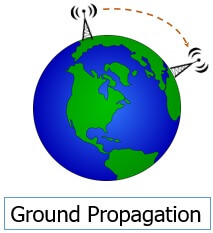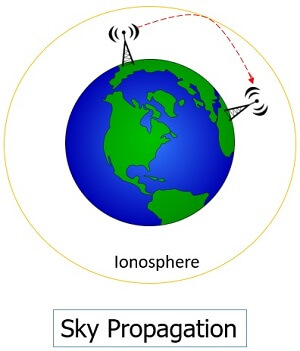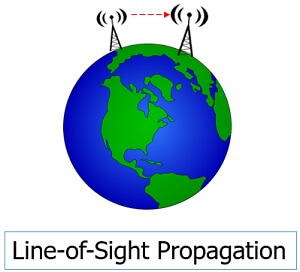The unguided transmission media is one which does not use the physical medium to transmit information from one computer to another. Unlike the guided transmission media, the unguided transmission media utilize air as a transmission media instead of wire or cable so it is also termed as ‘wireless transmission media’.
The wired or guided transmission media are good at their service then why we need the unguided or wireless transmission media? Well, it was not possible to install the fibre, wire, cable in a hilly area, jungles, swamps etc. In these circumstances, wireless or unguided transmission media performs better.
The unguided media uses an antenna for transmitting and receiving the electromagnetic wave. Now before going into the classification of unguided transmission media let us talk about the antenna and electromagnetic wave.
Electromagnetic Wave & Antenna
The electromagnetic wave is nothing but the moving electrons that propagates information from one point to the another through the air or even in a vacuum. An antenna is an electronic conductor that has the ability to transmit these electromagnetic waves and it can even receive these waves.
The unguided media propagates electromagnetic wave from source to destination in three methods:
1. Ground Propagation
In the ground propagation, the electromagnetic wave is propagated close to the atmosphere i.e. between ionosphere and earth surface. These electromagnetic waves are the low-frequency wave that is transmitted in all direction and the wave follows the curvature of the earth as you can see in the image below.
 The distance travel by the electromagnetic wave in the ground propagation depends on the power of the propagated signal. More is power in signal longer the distance it travels.
The distance travel by the electromagnetic wave in the ground propagation depends on the power of the propagated signal. More is power in signal longer the distance it travels.
2. Sky Propagation
In sky propagation, the electromagnetic wave with a higher frequency is radiated up in the ionosphere from the source transmitter antenna which gets reflected back to the earth surface. In skywave propagation, the electromagnetic wave travels a longer distance and it can be received thousands of kilometres away from the transmitter.

3. Line of Sight Propagation
In the line of sight propagation, the electromagnetic wave with very high frequency is transmitted in the ‘straight-line’ direction from the transmitter antenna to the receiver antenna.
 In this way, the electromagnetic wave does not get affected by the curvature of the earth because the transmitter and receiver antenna are either tall or close enough to maintain the line of sight.
In this way, the electromagnetic wave does not get affected by the curvature of the earth because the transmitter and receiver antenna are either tall or close enough to maintain the line of sight.
So far, we have discussed the electromagnetic wave, antenna and modes of propagation. In the section ahead, we will discuss three types of unguided transmission media or wireless transmission media.
Types of Unguided Transmission Media
Radio Transmission
The radio waves are the low-frequency electromagnetic wave ranging from ‘3 kHz to 1GHz’. As the radio waves are the low-frequency waves, they can penetrate walls and you can receive signals even if you are inside the building. But this property of radio wave, prevent you from isolating communication inside and outside the building.
The radio waves are propagated in sky mode and are omnidirectional which means that the source transmitter transmits the radio wave in the sky and they are reflected from the sky and received by the receiving antenna.
For radio transmission, the source transmitting antenna and receiving antenna are not required to be aligned to each other. As radio transmission uses sky propagation the signal can be broadcasted over a long distance.
Being omnidirectional in nature the radio waves can face issues such as interference if another transmitting antenna is also sending a signal with the same frequency or bandwidth.
Microwave Transmission
The microwave is the electromagnetic waves with frequency ranging from ‘1 to 300 GHz’. The microwaves are unidirectional in nature and due to which it propagates in line-of-sight mode. In line-of-sight propagation, the source transmitting antenna and the receiving antenna needs to aligned to each other in such a way that they must be facing each other which enables point-to-point transmission.
The microwave transmission can be classified into two types:
- Terrestrial Microwave Transmission
In terrestrial microwave transmission, the transmitting and receiving antenna both are fixed on the ground and the signal wave is transmitted using the line of sight propagation mode. It is mostly used for telecommunication. - Satellite Microwave Transmission
In satellite microwave transmission the electromagnetic wave is transmitted by the source transmitting antenna (earth station) which is received by satellite which amplifies the signal and rebroadcast it to the receiver antenna (earth station). Satellite microwave transmission is mostly used for television, long-distance telecommunication, and global positioning system.
Infrared Transmission
Infrared wave is the high-frequency wave ranging from ‘300 GHz to 400 THz’. The infrared transmission uses line-of-sight propagation and thereby is used for short-distance communication.
As the infrared transmission is the high-frequency waves, they cannot penetrate the wall so you can easily differentiate the communication going on inside the building and the communication outside a building. In this way, there are no chances of interferences.
The most popular example of infrared transmission that we daily come across is your remote that you use to operate AC, television, music system, etc. The remote emits infrared waves which are received by the television and according to perform the action.
Well, as the frequency of the electromagnetic wave rises and we move from radio wave toward the visible light, the electromagnetic wave behaves more like a light.
When it comes to security the infrared waves are more secure as there is no chance of eavesdropping because the infrared wave does not even penetrate the wall. Therefore, you do not even require a license to use infrared transmission.
So, these all are types of unguided transmission media. We have also learnt about the modes of propagation that provides the way to the electromagnetic wave to travel from source to destination.

angel semino says
I conceive you have mentioned some very interesting details, regards for the post.
Miriam says
Thank you so much. This information is well detailed using the very simple language that can be grasped by everyone. I
Mike mwila says
The information being provided is very way to comprehend in such a way that it tremendously raises the interest and eagerness of studying and having replenishment insight.
thamel says
wow nicely explained in simple language .. Very easy to understand…